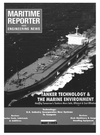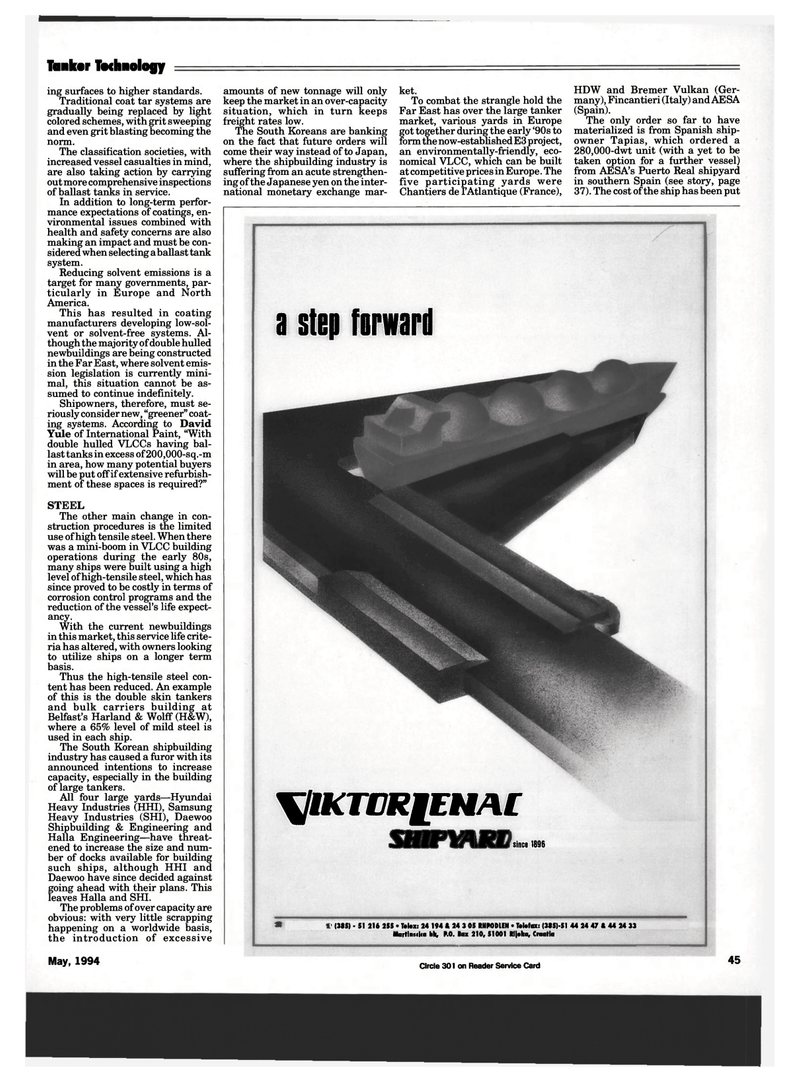
Page 43: of Maritime Reporter Magazine (May 1994)
Read this page in Pdf, Flash or Html5 edition of May 1994 Maritime Reporter Magazine
Tanker Technology ing surfaces to higher standards.
Traditional coat tar systems are gradually being replaced by light colored schemes, with grit sweeping and even grit blasting becoming the norm.
The classification societies, with increased vessel casualties in mind, are also taking action by carrying out more comprehensive inspections of ballast tanks in service.
In addition to long-term perfor- mance expectations of coatings, en- vironmental issues combined with health and safety concerns are also making an impact and must be con- sidered when selecting a ballast tank system.
Reducing solvent emissions is a target for many governments, par- ticularly in Europe and North
America.
This has resulted in coating manufacturers developing low-sol- vent or solvent-free systems. Al- though the majority of double hulled newbuildings are being constructed in the Far East, where solvent emis- sion legislation is currently mini- mal, this situation cannot be as- sumed to continue indefinitely.
Shipowners, therefore, must se- riously consider new, "greener" coat- ing systems. According to David
Yule of International Paint, "With double hulled VLCCs having bal- last tanks in excess of200,000-sq.-m in area, how many potential buyers will be put off if extensive refurbish- ment of these spaces is required?"
STEEL
The other main change in con- struction procedures is the limited use of high tensile steel. When there was a mini-boom in VLCC building operations during the early 80s, many ships were built using a high level of high-tensile steel, which has since proved to be costly in terms of corrosion control programs and the reduction of the vessel's life expect- ancy.
With the current newbuildings in this market, this service life crite- ria has altered, with owners looking to utilize ships on a longer term basis.
Thus the high-tensile steel con- tent has been reduced. An example of this is the double skin tankers and bulk carriers building at
Belfast's Harland & Wolff (H&W), where a 65% level of mild steel is used in each ship.
The South Korean shipbuilding industry has caused a furor with its announced intentions to increase capacity, especially in the building of large tankers.
All four large yards—Hyundai
Heavy Industries (HHI), Samsung
Heavy Industries (SHI), Daewoo
Shipbuilding & Engineering and
Halla Engineering—have threat- ened to increase the size and num- ber of docks available for building such ships, although HHI and
Daewoo have since decided against going ahead with their plans. This leaves Halla and SHI.
The problems of over capacity are obvious: with very little scrapping happening on a worldwide basis, the introduction of excessive amounts of new tonnage will only keep the market in an over-capacity situation, which in turn keeps freight rates low.
The South Koreans are banking on the fact that future orders will come their way instead of to Japan, where the shipbuilding industry is suffering from an acute strengthen- ing of the Japanese yen on the inter- national monetary exchange mar- ket.
To combat the strangle hold the
Far East has over the large tanker market, various yards in Europe got together during the early '90s to form the now-established E3 project, an environmentally-friendly, eco- nomical VLCC, which can be built at competitive prices in Europe. The five participating yards were
Chantiers de I'Atlantique (France),
HDW and Bremer Vulkan (Ger- many), Fincantieri (Italy) and AESA (Spain).
The only order so far to have materialized is from Spanish ship- owner Tapias, which ordered a 280,000-dwt unit (with a yet to be taken option for a further vessel) from AESA's Puerto Real shipyard in southern Spain (see story, page 37). The cost of the ship has been put
XllKTDRgENAC
SHIPYARD since 1896 ' (385) - SI 216 255 • Ukx: 24 194 « 24 3 05 RHPODliN • UMax: (3851-51 44 24 47 ft 44 24 33
Mqrtlnsiiio bk, P.O. lax 210, 51001 Rli*ko, Croatia a step forward
May, 1994 Circle 301 on Reader Service Card 45

 42
42

 44
44
